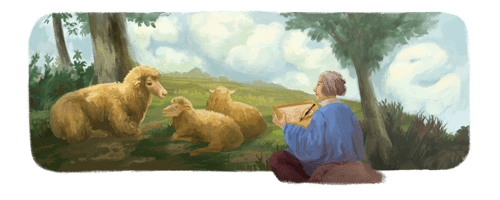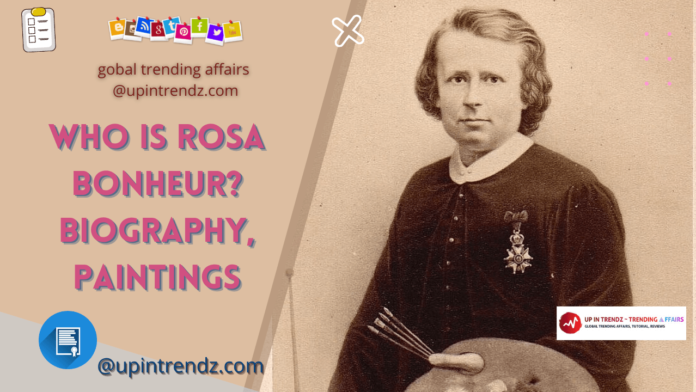Who is Rosa Bonheur? Biography, Paintings : Google Celebrates French Artist Rosa Bonheur’s 200th Birthday With A Doodle.
Google today celebrates the 200th birthday of French painter Rosa Bonheur, whose successful career inspired a future generation of women in the arts.

Page Contents
Who is Rosa Bonheur? Short Introduction
| Name | Marie-Rosalie Bonheur |
| Born | 16 March 1822, Bordeaux, France |
| Died | 25 May 1899 (aged 77), Thomery, France |
| Nationality | French |
| Known for | Painting, sculpture |
| Notable work | Ploughing in the Nivernais, The Horse Fair |
| Movement | Realism |
| Parent(s) | Oscar-Raymond Bonheur(father) |
Rosa Bonheur Biography, Birth, Early Life, Education
Rosa Bonheur (born Marie-Rosalie Bonheur; 16 March 1822 – 25 May 1899), was a French artist, mostly a painter of animals but also a sculptor, in a realist style.
Her paintings include Ploughing in the Nivernais, first exhibited at the Paris Salon of 1848, and now at the Musée d’Orsay in Paris, and The Horse Fair (in French: Le marché aux chevaux), which was exhibited at the Salon of 1853 (finished in 1855) and is now in the Metropolitan Museum of Art, in New York City.
Bonheur was widely considered to be the most famous female painter of the nineteenth century.
Bonheur was openly lesbian. She lived with her partner Nathalie Micas for over 40 years until Micas’ death, after which she began a relationship with American painter Anna Elizabeth Klumpke.
Rosa Bonheur Birth, Early Life
Bonheur was born on 16 March 1822 in Bordeaux, Gironde, the oldest child in a family of artists.
Her mother was Sophie Bonheur (born Marquis), a piano teacher; she died when Rosa was eleven. Her father was Oscar-Raymond Bonheur, a landscape and portrait painter who encouraged his daughter’s artistic talents.
Though of Jewish origin, the Bonheur family adhered to Saint-Simonianism, a Christian-socialist sect that promoted the education of women alongside men.
Bonheur’s siblings included the animal painters Auguste Bonheur and Juliette Bonheur, as well as the animal sculptor Isidore Jules Bonheur. Francis Galton used the Bonheurs as an example of “Hereditary Genius” in his 1869 essay of the same title.
Read More Trending Articles :
- What is NATO? Full Form, Countries, History, Map, & Facts
- Ratan Tata Biography : Age, Net Worth, Education, Family, Quotes
- World Hearing Day 2025: Theme, History, Slogan, Significance
- Jamsetji Tata Biography : Birth, Family, Education, Career, Quotes
- World Wildlife Day 2025 : Theme, Quotes, Wishes, Messages, Slogans
Rosa Bonheur Education
Bonheur moved to Paris in 1828 at the age of six with her mother and siblings, after her father had gone ahead of them to establish a residence and income there.
By family accounts, she had been an unruly child and had a difficult time learning to read, though she would sketch for hours at a time with pencil and paper before she learned to talk.
Her mother taught her to read and write by asking her to choose and draw a different animal for each letter of the alphabet. The artist credited her love of drawing animals to these reading lessons with her mother.
At school she was often disruptive, and was expelled numerous times. After a failed apprenticeship with a seamstress at the age of twelve, her father undertook her training as a painter.
Her father allowed her to pursue her interest in painting animals by bringing live animals to the family’s studio for studying.
Following the traditional art school curriculum of the period, Bonheur began her training by copying images from drawing books and by sketching plaster models.
At fourteen, she began to copy paintings at the Louvre.
She studied animal anatomy and osteology in the abattoirs of Paris and dissected animals at the École nationale vétérinaire d’Alfort, the National Veterinary Institute in Paris.
Trending Topics:
- Happy Holi 2025: Greetings, Wishes, Messages, Quotes, images
- Bihar Board 12th Result 2025 Live: BSEB 12th Result Released
- Who is Rosa Bonheur? Biography, Paintings
- ow Desi Ghee health benefits: Skin, Weight Lose | Side Effects
Personal life and legacy
Women were often only reluctantly educated as artists in Bonheur’s day, and by becoming such a successful artist she helped to open doors to the women artists that followed her.
Bonheur was known for wearing men’s clothing; she attributed her choice of trousers to their practicality for working with animals (see Rational dress).
Her romantic life was that of a lesbian. However, there is no confirmation that her relationships with women were sexual.
At a time when lesbian sex – particularly tribadism – was regarded as animalistic and deranged by most French officials, Bonheur’s outspokenness about her personal life was groundbreaking.
Biographical works
The first biography of Bonheur was published during her lifetime: a pamphlet written by Eugène de Mirecourt, Les Contemporains: Rosa Bonheur, which appeared just after her Salon success with The Horse Fair in 1856. Bonheur later corrected and annotated this document.
Late Period and Death
Bonheur was extremely happy in her secluded existence in the village of By. She usually began her day at dawn, walking to find a suitable place in the forest where she could work until dusk.
By 1893, Rosa had recovered some of her characteristic energy and traveled to the United States for a tour of the Women’s Building at the World’s Columbian Exposition in Chicago. A young American female artist had contacted the artist in 1889 and asked to paint her portrait but Rosa did not feel up to the task at the time.
Klumpke, in spite of the disapproval of both her own family and Bonheur’s, managed Bonheur’s estate for the rest of her life. Since Bonheur had named her the heir of the estate, Klumpke presided over the sale of 892 paintings and numerous other artworks, selling most in 1900 for 72 million francs.
In 1924, Klumpke opened the Musée Rosa Bonheur in By, and established the Rosa Bonheur Memorial Art School which would offer art instruction to women.
In 1940 Klumpke published ‘Memoirs of an Artist’ and died in 1942. Her ashes were later entombed alongside Rosa Bonheur and Nathalie Micas in Père Lachaise cemetery.
Source External Links
- NMWA.org Collection Profile – Bonheur article and artwork at NMWA
- Rosa Bonheur, The Horse Fair, Metropolitan Museum of Art
- 10 Famous Female Painters Every Art Lover Should Know”. My Modern Met
- Rosa Bonheur, Encyclopædia Britannica Online
- Rosa Bonheur, Wikipedia
- httpsssss://www.theartstory.org/artist/bonheur-rosa/life-and-legacy
What you have learned today
I sincerely hope that I have given you all the information about “Who is Rosa Bonheur? Biography, Paintings” and I hope you have understood about this. Get more details on various Trending Topics.
It has always been my endeavor to always help my readers, if you people have any doubt of any kind then you can ask me without hesitation.
How do you find out this article “Who is Rosa Bonheur? Biography, Paintings”, please let us know by writing a comment so that we can also learn something from your ideas and improve something.


